前言
随着人工智能的不断发展,机器学习这门技术也越来越重要,很多人都开启了学习机器学习,本文就介绍了机器学习的基础内容。来源于哔哩哔哩博主“霹雳吧啦Wz”,博主学习作为笔记记录,欢迎大家一起讨论学习交流。
一、搭建MobileNet网络
用MobileNetv2学习,轮次训练5轮次(代码),五个epoch2分钟,设备太重要了(服务器显卡P4000,网上说相当于1070)。
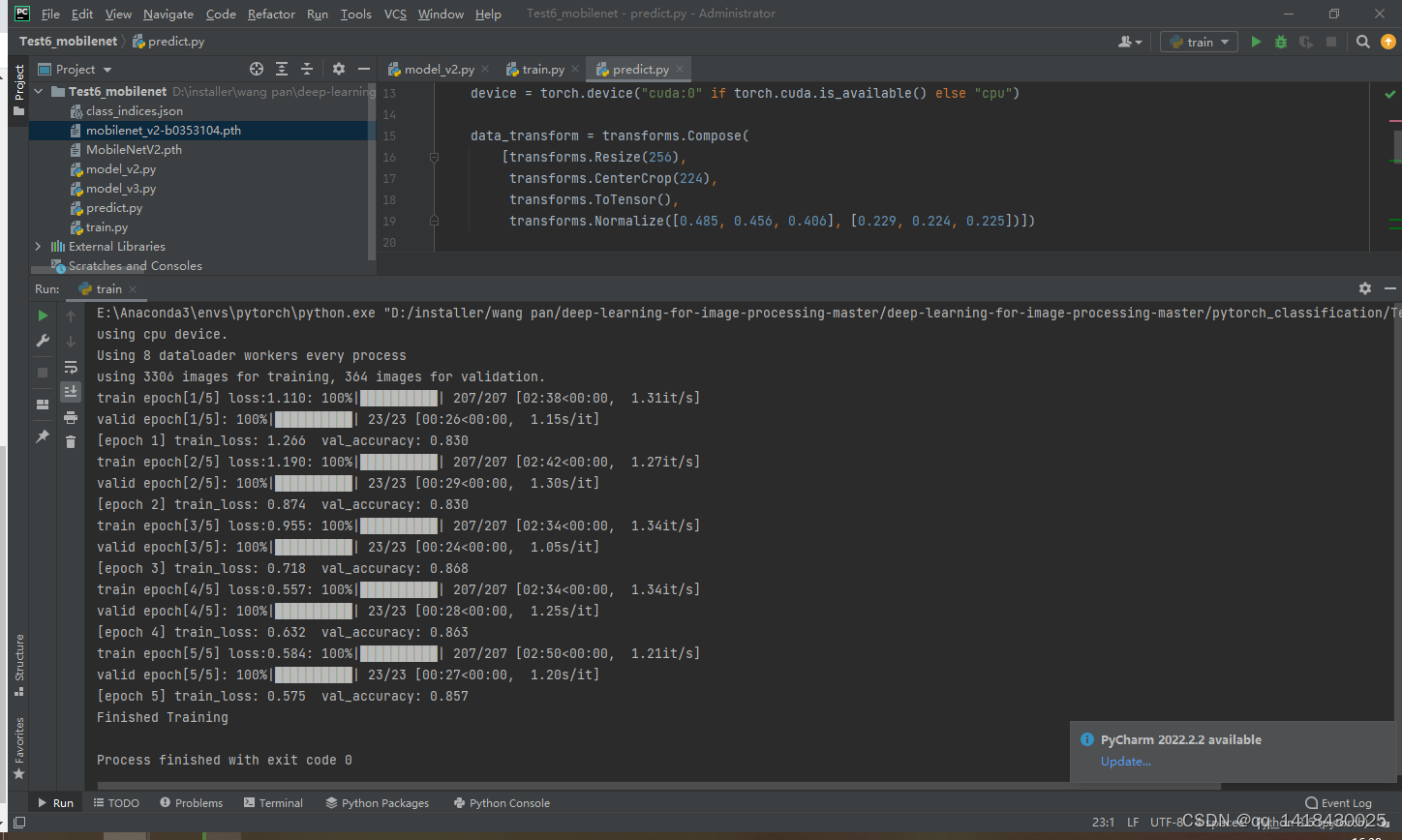
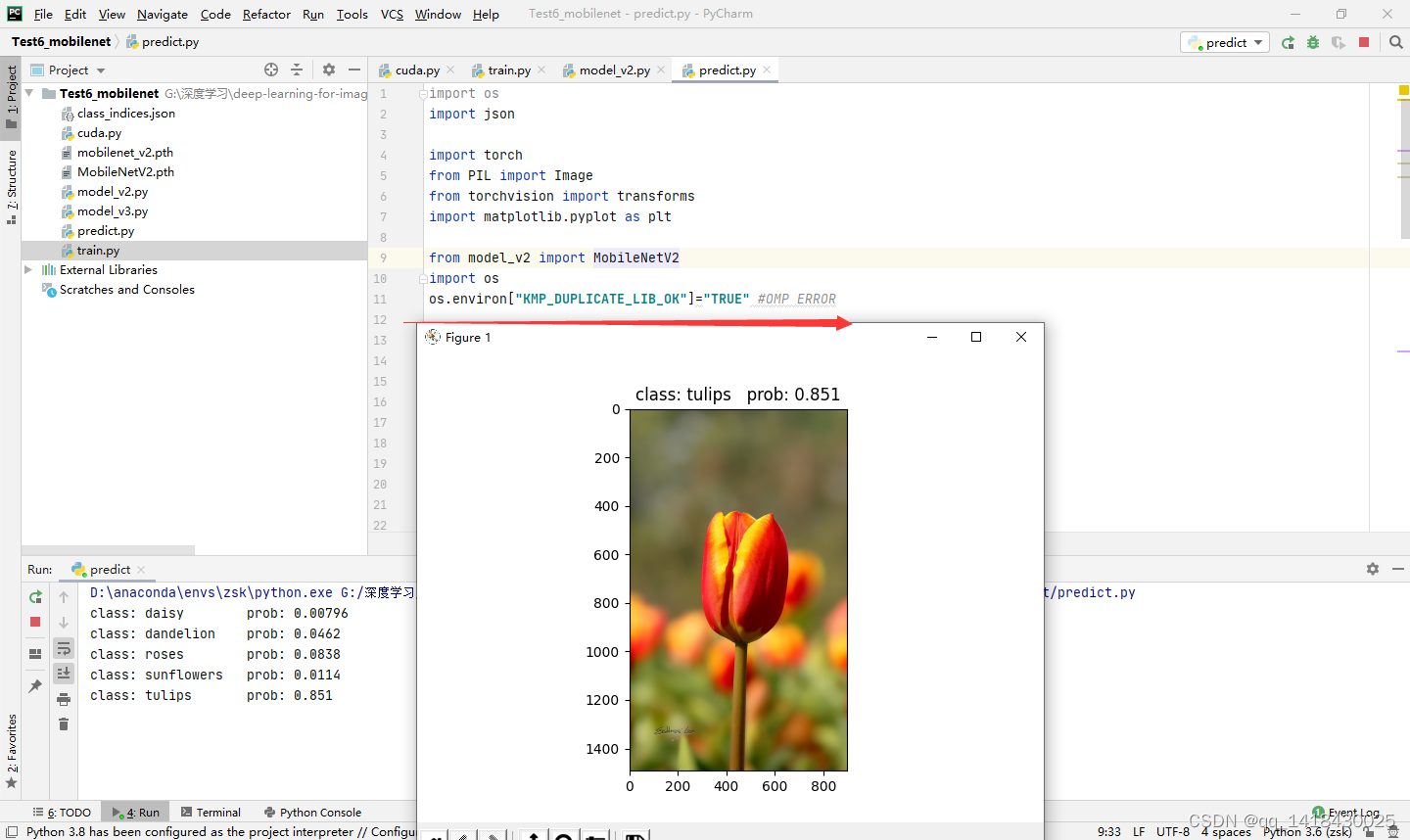
二、代码部分
1.module.py----定义MobileNet的网络结构
代码如下(示例):
from torch import nn
import torch
def _make_divisible(ch, divisor=8, min_ch=None):
"""
This function is taken from the original tf repo.
It ensures that all layers have a channel number that is divisible by 8
It can be seen here:
https://github.com/tensorflow/models/blob/master/research/slim/nets/mobilenet/mobilenet.py
"""
if min_ch is None:
min_ch = divisor
new_ch = max(min_ch, int(ch + divisor / 2) // divisor * divisor)
# Make sure that round down does not go down by more than 10%.
if new_ch < 0.9 * ch:
new_ch += divisor
return new_ch
class ConvBNReLU(nn.Sequential):
def __init__(self, in_channel, out_channel, kernel_size=3, stride=1, groups=1):
padding = (kernel_size - 1) // 2
super(ConvBNReLU, self).__init__(
nn.Conv2d(in_channel, out_channel, kernel_size, stride, padding, groups=groups, bias=False),
nn.BatchNorm2d(out_channel),
nn.ReLU6(inplace=True)
)
class InvertedResidual(nn.Module):
def __init__(self, in_channel, out_channel, stride, expand_ratio):
super(InvertedResidual, self).__init__()
hidden_channel = in_channel * expand_ratio
self.use_shortcut = stride == 1 and in_channel == out_channel
layers = []
if expand_ratio != 1:
# 1x1 pointwise conv
layers.append(ConvBNReLU(in_channel, hidden_channel, kernel_size=1))
layers.extend([
# 3x3 depthwise conv
ConvBNReLU(hidden_channel, hidden_channel, stride=stride, groups=hidden_channel),
# 1x1 pointwise conv(linear)
nn.Conv2d(hidden_channel, out_channel, kernel_size=1, bias=False),
nn.BatchNorm2d(out_channel),
])
self.conv = nn.Sequential(*layers)
def forward(self, x):
if self.use_shortcut:
return x + self.conv(x)
else:
return self.conv(x)
class MobileNetV2(nn.Module):
def __init__(self, num_classes=1000, alpha=1.0, round_nearest=8):
super(MobileNetV2, self).__init__()
block = InvertedResidual
input_channel = _make_divisible(32 * alpha, round_nearest)
last_channel = _make_divisible(1280 * alpha, round_nearest)
inverted_residual_setting = [
# t, c, n, s
[1, 16, 1, 1],
[6, 24, 2, 2],
[6, 32, 3, 2],
[6, 64, 4, 2],
[6, 96, 3, 1],
[6, 160, 3, 2],
[6, 320, 1, 1],
]
features = []
# conv1 layer
features.append(ConvBNReLU(3, input_channel, stride=2))
# building inverted residual residual blockes
for t, c, n, s in inverted_residual_setting:
output_channel = _make_divisible(c * alpha, round_nearest)
for i in range(n):
stride = s if i == 0 else 1
features.append(block(input_channel, output_channel, stride, expand_ratio=t))
input_channel = output_channel
# building last several layers
features.append(ConvBNReLU(input_channel, last_channel, 1))
# combine feature layers
self.features = nn.Sequential(*features)
# building classifier
self.avgpool = nn.AdaptiveAvgPool2d((1, 1))
self.classifier = nn.Sequential(
nn.Dropout(0.2),
nn.Linear(last_channel, num_classes)
)
# weight initialization
for m in self.modules():
if isinstance(m, nn.Conv2d):
nn.init.kaiming_normal_(m.weight, mode='fan_out')
if m.bias is not None:
nn.init.zeros_(m.bias)
elif isinstance(m, nn.BatchNorm2d):
nn.init.ones_(m.weight)
nn.init.zeros_(m.bias)
elif isinstance(m, nn.Linear):
nn.init.normal_(m.weight, 0, 0.01)
nn.init.zeros_(m.bias)
def forward(self, x):
x = self.features(x)
x = self.avgpool(x)
x = torch.flatten(x, 1)
x = self.classifier(x)
return x
2.train.py----加载数据集并进行训练,训练集计算loss,测试集计算accuracy,保存训练好的网络参数
代码如下(示例):
import os
import sys
import json
import torch
import torch.nn as nn
import torch.optim as optim
from torchvision import transforms, datasets
from tqdm import tqdm
from model_v2 import MobileNetV2
def main():
device = torch.device("cuda:0" if torch.cuda.is_available() else "cpu")
print("using {} device.".format(device))
batch_size = 16
epochs = 5
data_transform = {
"train": transforms.Compose([transforms.RandomResizedCrop(224),
transforms.RandomHorizontalFlip(),
transforms.ToTensor(),
transforms.Normalize([0.485, 0.456, 0.406], [0.229, 0.224, 0.225])]),
"val": transforms.Compose([transforms.Resize(256),
transforms.CenterCrop(224),
transforms.ToTensor(),
transforms.Normalize([0.485, 0.456, 0.406], [0.229, 0.224, 0.225])])}
data_root = os.path.abspath(os.path.join(os.getcwd(), "../..")) # get data root path
image_path = os.path.join(data_root, "data_set", "flower_data") # flower data set path
assert os.path.exists(image_path), "{} path does not exist.".format(image_path)
train_dataset = datasets.ImageFolder(root=os.path.join(image_path, "train"),
transform=data_transform["train"])
train_num = len(train_dataset)
# {'daisy':0, 'dandelion':1, 'roses':2, 'sunflower':3, 'tulips':4}
flower_list = train_dataset.class_to_idx
cla_dict = dict((val, key) for key, val in flower_list.items())
# write dict into json file
json_str = json.dumps(cla_dict, indent=4)
with open('class_indices.json', 'w') as json_file:
json_file.write(json_str)
nw = min([os.cpu_count(), batch_size if batch_size > 1 else 0, 8]) # number of workers
print('Using {} dataloader workers every process'.format(nw))
train_loader = torch.utils.data.DataLoader(train_dataset,
batch_size=batch_size, shuffle=True,
num_workers=nw)
validate_dataset = datasets.ImageFolder(root=os.path.join(image_path, "val"),
transform=data_transform["val"])
val_num = len(validate_dataset)
validate_loader = torch.utils.data.DataLoader(validate_dataset,
batch_size=batch_size, shuffle=False,
num_workers=nw)
print("using {} images for training, {} images for validation.".format(train_num,
val_num))
# create model
net = MobileNetV2(num_classes=5)
# load pretrain weights
# download url: https://download.pytorch.org/models/mobilenet_v2-b0353104.pth
model_weight_path = "./mobilenet_v2.pth"
assert os.path.exists(model_weight_path), "file {} dose not exist.".format(model_weight_path)
pre_weights = torch.load(model_weight_path, map_location='cpu')
# delete classifier weights
pre_dict = {k: v for k, v in pre_weights.items() if net.state_dict()[k].numel() == v.numel()}
missing_keys, unexpected_keys = net.load_state_dict(pre_dict, strict=False)
# freeze features weights
for param in net.features.parameters():
param.requires_grad = False
net.to(device)
# define loss function
loss_function = nn.CrossEntropyLoss()
# construct an optimizer
params = [p for p in net.parameters() if p.requires_grad]
optimizer = optim.Adam(params, lr=0.0001)
best_acc = 0.0
save_path = './MobileNetV2.pth'
train_steps = len(train_loader)
for epoch in range(epochs):
# train
net.train()
running_loss = 0.0
train_bar = tqdm(train_loader, file=sys.stdout)
for step, data in enumerate(train_bar):
images, labels = data
optimizer.zero_grad()
logits = net(images.to(device))
loss = loss_function(logits, labels.to(device))
loss.backward()
optimizer.step()
# print statistics
running_loss += loss.item()
train_bar.desc = "train epoch[{}/{}] loss:{:.3f}".format(epoch + 1,
epochs,
loss)
# validate
net.eval()
acc = 0.0 # accumulate accurate number / epoch
with torch.no_grad():
val_bar = tqdm(validate_loader, file=sys.stdout)
for val_data in val_bar:
val_images, val_labels = val_data
outputs = net(val_images.to(device))
# loss = loss_function(outputs, test_labels)
predict_y = torch.max(outputs, dim=1)[1]
acc += torch.eq(predict_y, val_labels.to(device)).sum().item()
val_bar.desc = "valid epoch[{}/{}]".format(epoch + 1,
epochs)
val_accurate = acc / val_num
print('[epoch %d] train_loss: %.3f val_accuracy: %.3f' %
(epoch + 1, running_loss / train_steps, val_accurate))
if val_accurate > best_acc:
best_acc = val_accurate
torch.save(net.state_dict(), save_path)
print('Finished Training')
if __name__ == '__main__':
main()
和之前train.py代码有不一样:预训练模型在IMAGENET训练得到的权重最后全连接展开是1000个类别,我们数据集是用的5个类别,所以要将其delete classifier weights并使训练效果更好,进行freeze features weights。
预训练权重下载方式:在train.py代码中输入:import torchvision.models.mobilenet进行查看。官方预训练权重链接
3.predict.py——得到训练好的网络参数后,用自己找的图像进行分类测试
import os
import json
import torch
from PIL import Image
from torchvision import transforms
import matplotlib.pyplot as plt
from model_v2 import MobileNetV2
def main():
device = torch.device("cuda:0" if torch.cuda.is_available() else "cpu")
data_transform = transforms.Compose(
[transforms.Resize(256),
transforms.CenterCrop(224),
transforms.ToTensor(),
transforms.Normalize([0.485, 0.456, 0.406], [0.229, 0.224, 0.225])])
# load image
img_path = "../tulip.jpg"
assert os.path.exists(img_path), "file: '{}' dose not exist.".format(img_path)
img = Image.open(img_path)
plt.imshow(img)
# [N, C, H, W]
img = data_transform(img)
# expand batch dimension
img = torch.unsqueeze(img, dim=0)
# read class_indict
json_path = './class_indices.json'
assert os.path.exists(json_path), "file: '{}' dose not exist.".format(json_path)
with open(json_path, "r") as f:
class_indict = json.load(f)
# create model
model = MobileNetV2(num_classes=5).to(device)
# load model weights
model_weight_path = "./MobileNetV2.pth"
model.load_state_dict(torch.load(model_weight_path, map_location=device))
model.eval()
with torch.no_grad():
# predict class
output = torch.squeeze(model(img.to(device))).cpu()
predict = torch.softmax(output, dim=0)
predict_cla = torch.argmax(predict).numpy()
print_res = "class: {} prob: {:.3}".format(class_indict[str(predict_cla)],
predict[predict_cla].numpy())
plt.title(print_res)
for i in range(len(predict)):
print("class: {:10} prob: {:.3}".format(class_indict[str(i)],
predict[i].numpy()))
plt.show()
if __name__ == '__main__':
main()
三、MobileNetv1
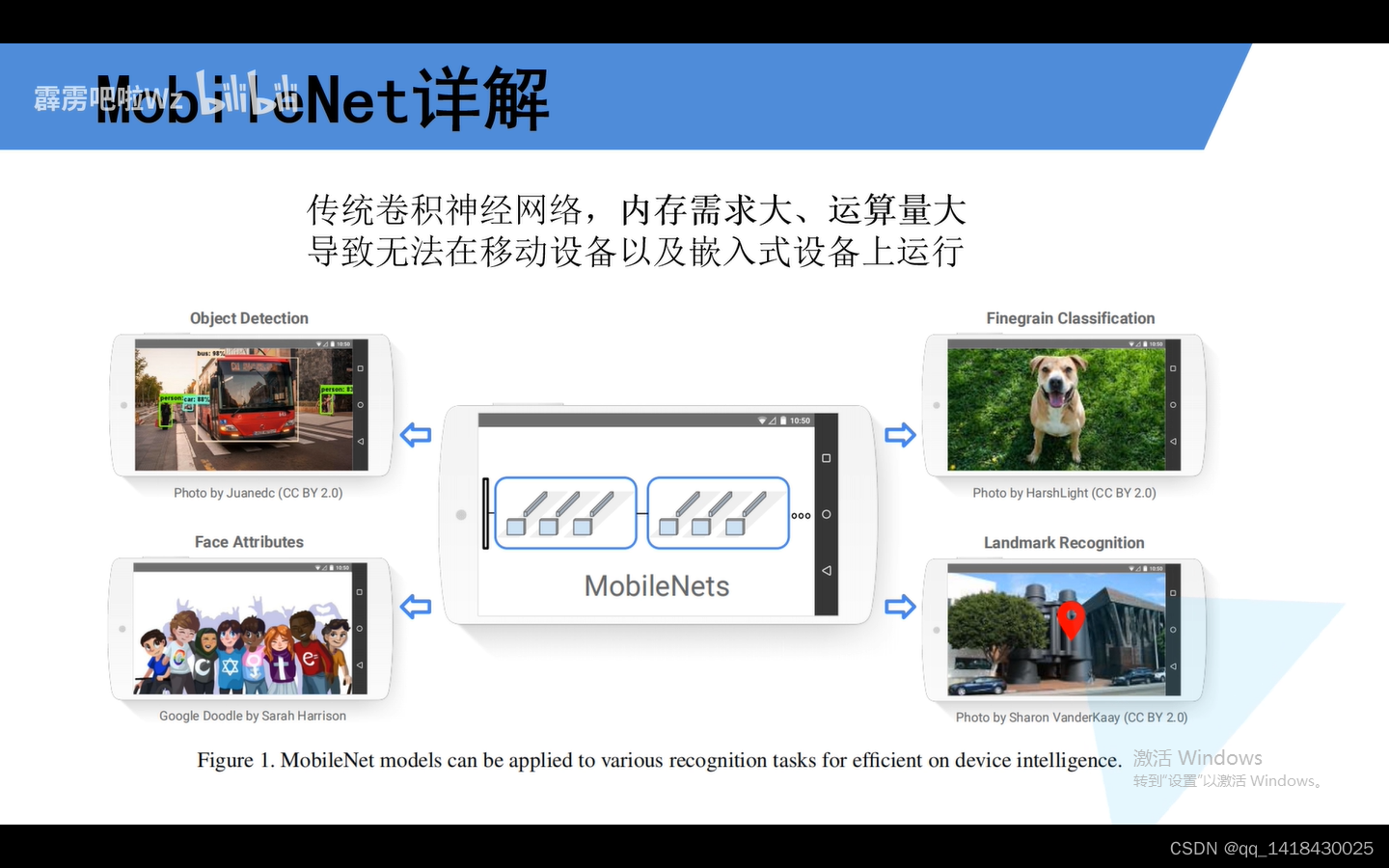
VGG16权重文件大概有490MB,Resnet152权重文件大概有644MB,对于移动设备和嵌入式不大现实。

MobileNet就是一个轻量级网络:精确度降低非常少,可以忽略的前提,模型的参数可以减少原来的32倍。也是牛逼,自我感觉,就是深度学习一直都是在刷榜单,我们要top最好的精确度,看谁是老大,但是MobileNet感觉是在首先在参数上进行创新,而且不影响精确度,就是走了一个极少数当时不热的方向,结果证明是可行的。(通过DW卷积实现减少模型参数)
总结:MoileNet就是轻量级网络 (通过DW卷积实现减少模型参数)

传统卷积:卷积核的深度=输入特征矩阵的深度;输出矩阵的通道数=卷积核的个数
DW卷积:卷积核的深度=1;输入矩阵的通道数=卷积核的个数=输出特征矩阵的通道数(就是不改变输入和输出的通道数)
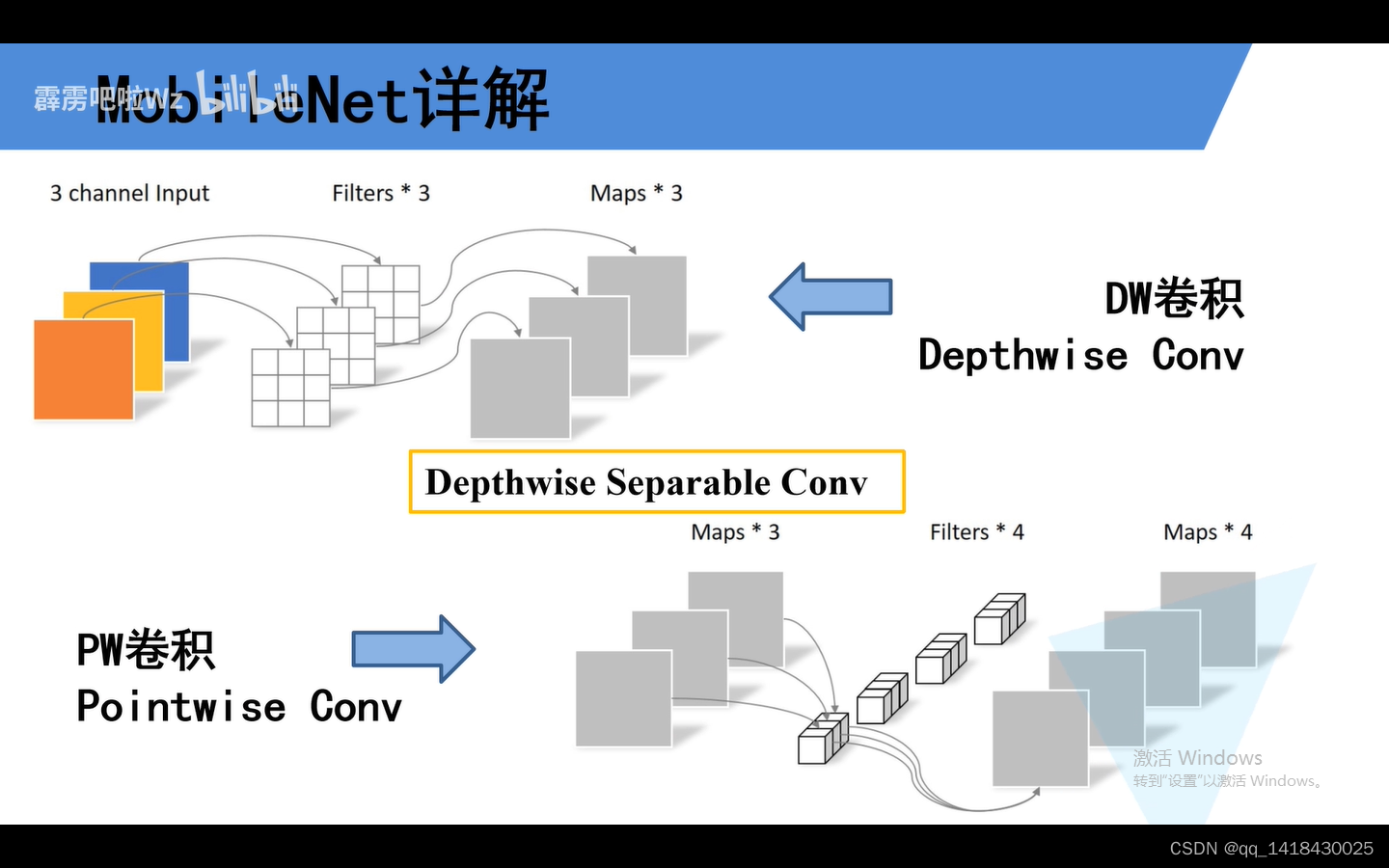
总结:DW卷积是卷积核的深度=1(1个卷积核只负责一个输入图像的深度);输入矩阵的通道数=卷积核的个数=输出特征矩阵的通道数(就是不改变输入和输出的通道数)
深度可分离卷积就是由DW卷积和PW卷积组成,其中PW卷积就是普通卷积,只不过卷积核大小是=1.(所以也满足普通卷积的特点:卷积核的深度与输入特征的深度一样,卷积核的个数与输出特征矩阵的通道数一样)
通常DW卷积是和PW卷积一起使用的,使用这种组合可以对比于普通的卷积,大大减少参数的参与。
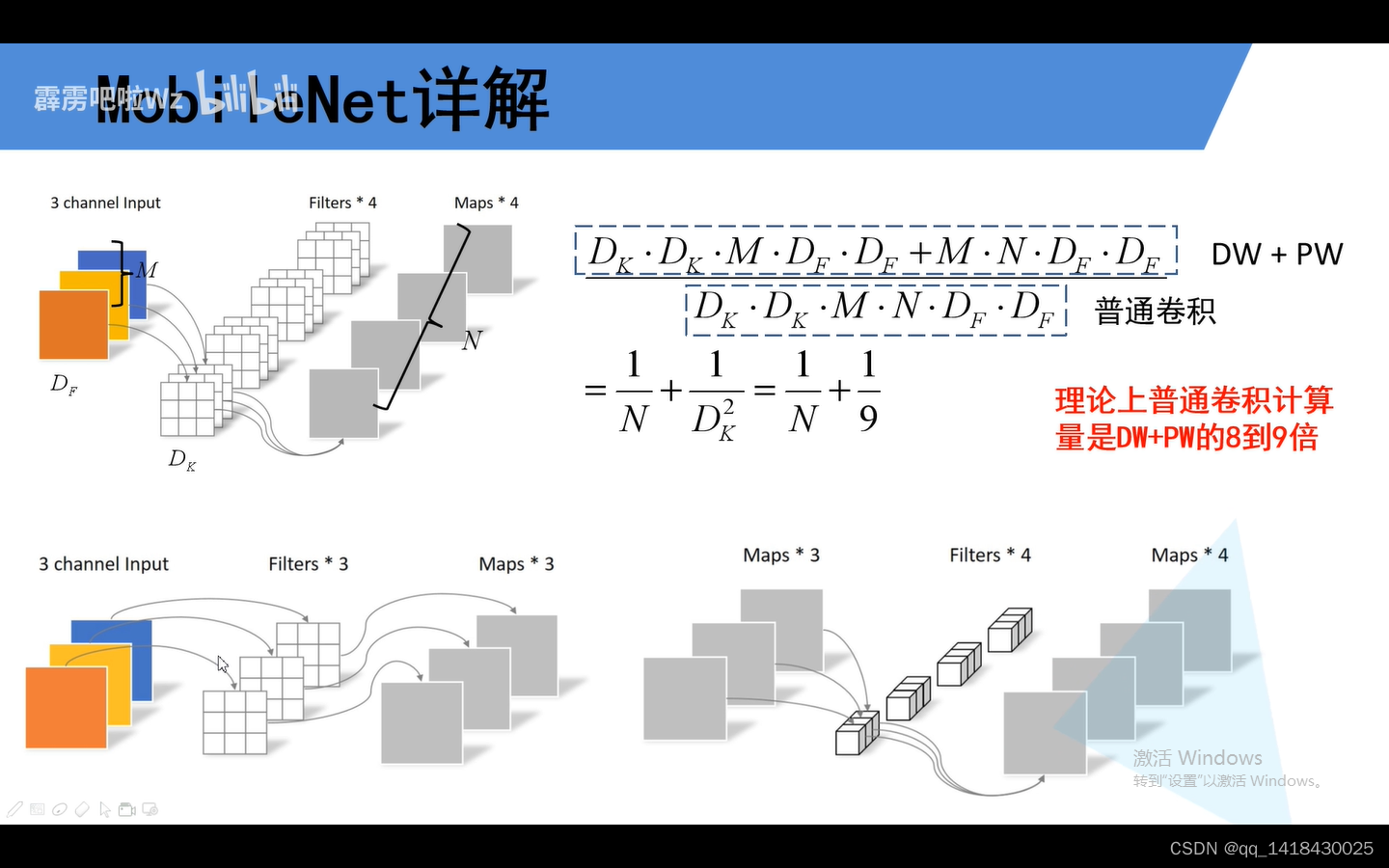
普通卷积:卷积核大小(DK DK)x输入特征矩阵深度(M)x输出特征矩阵深度(N)x输入特征矩阵大小(DF DF)
DW+PW卷积:卷积核大小(DK)x输入特征矩阵深度(1)x输出特征矩阵深度(M)x输入特征矩阵大小(DF DF)+卷积核大小(1X1)x输入特征矩阵深度(M)x输出特征矩阵深度(N)x输入特征矩阵大小(DF DF)
总结:理论上普通卷积计算量是DW+PW的8-9倍。
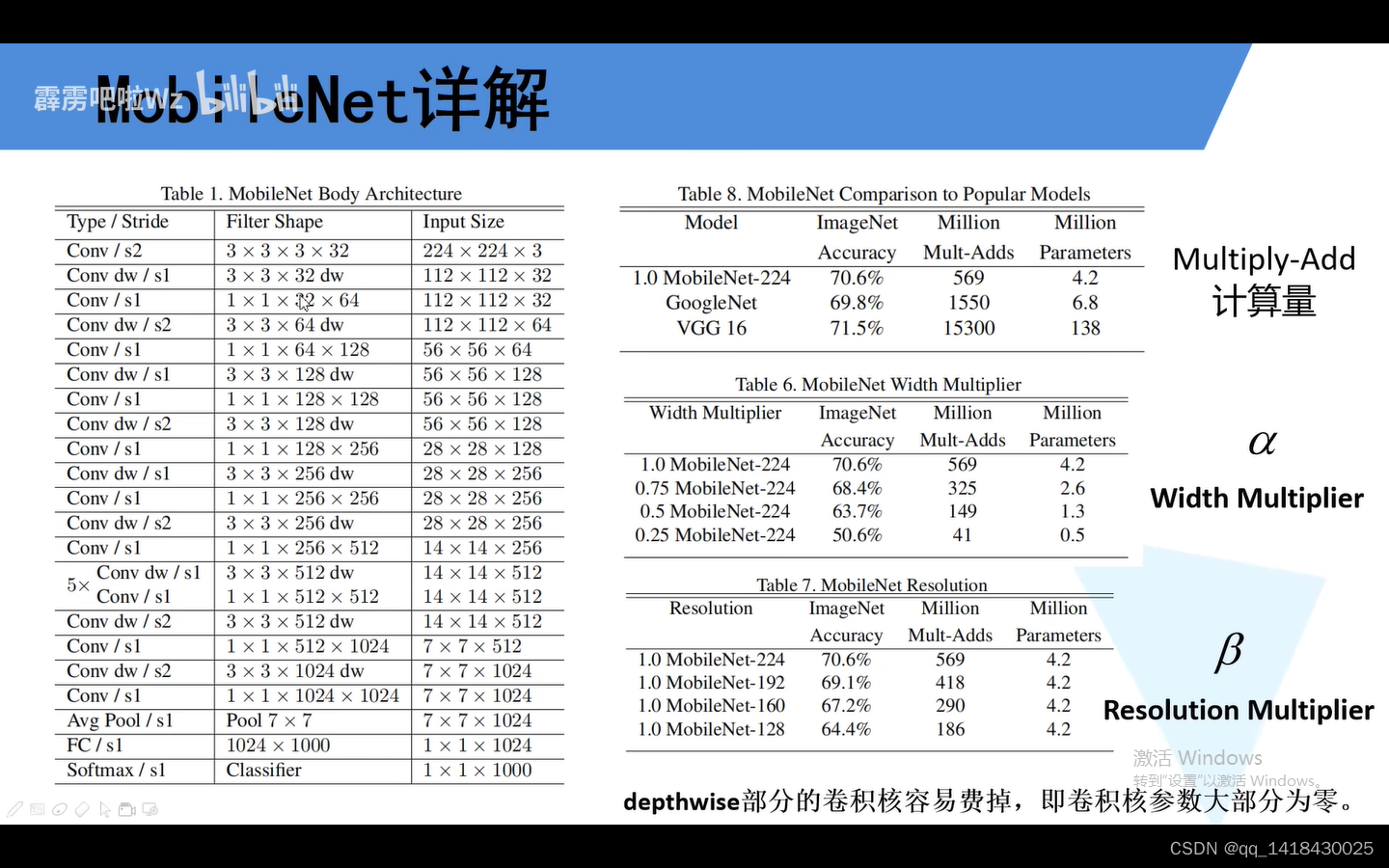
普通卷积Conv 步距 3x3x3x32 前两个3是卷积核的尺寸,第三个3是输入图像的深度,第四个3是卷积核的个数。DW卷积深度是1.
a是卷积核个数的倍率,β是分辨率参数。
四、MobileNetv2
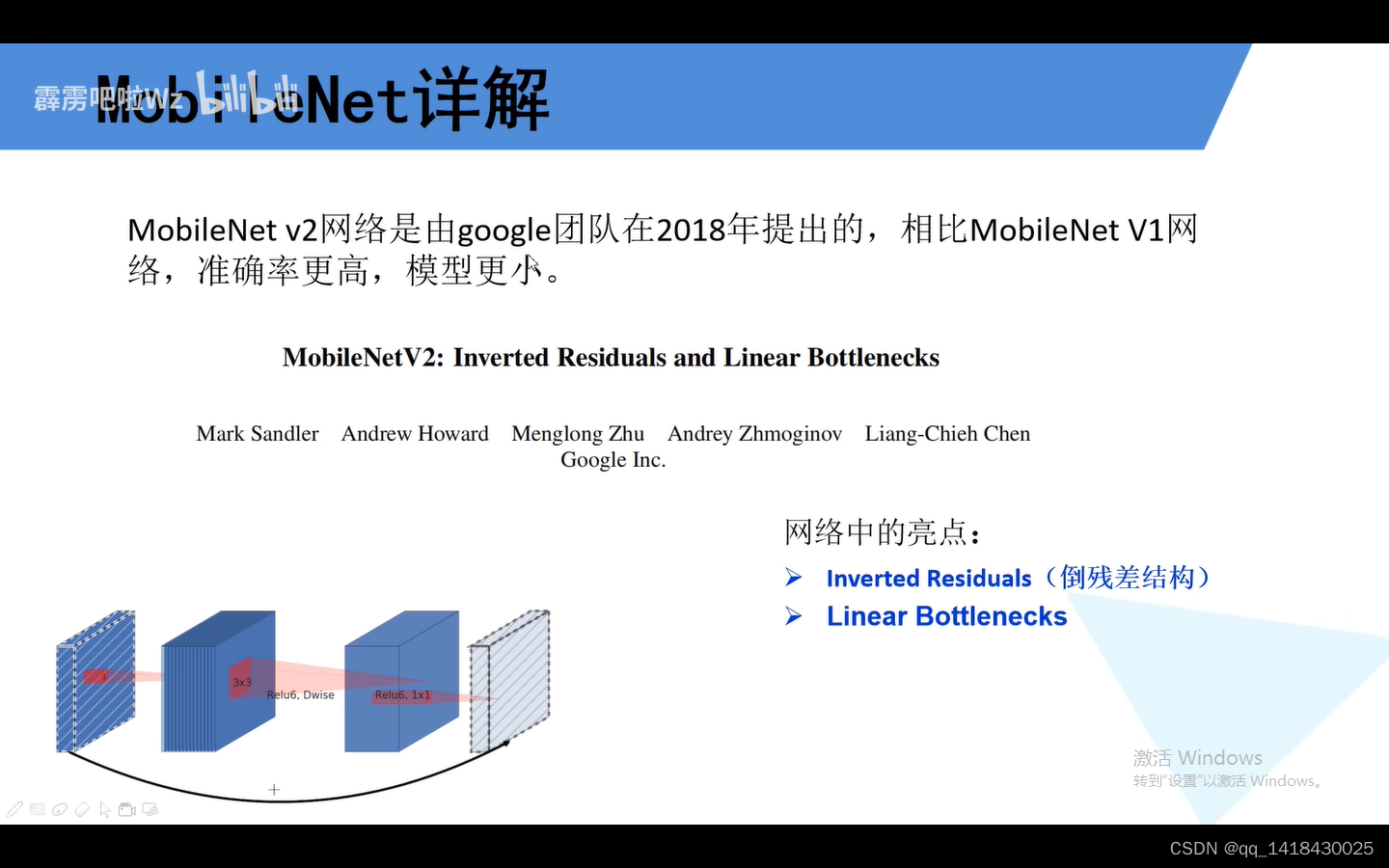
优点:倒残差结构inverted residuals+linear bottlenecks,这个两个优点就是MobileNetV2的论文题目。
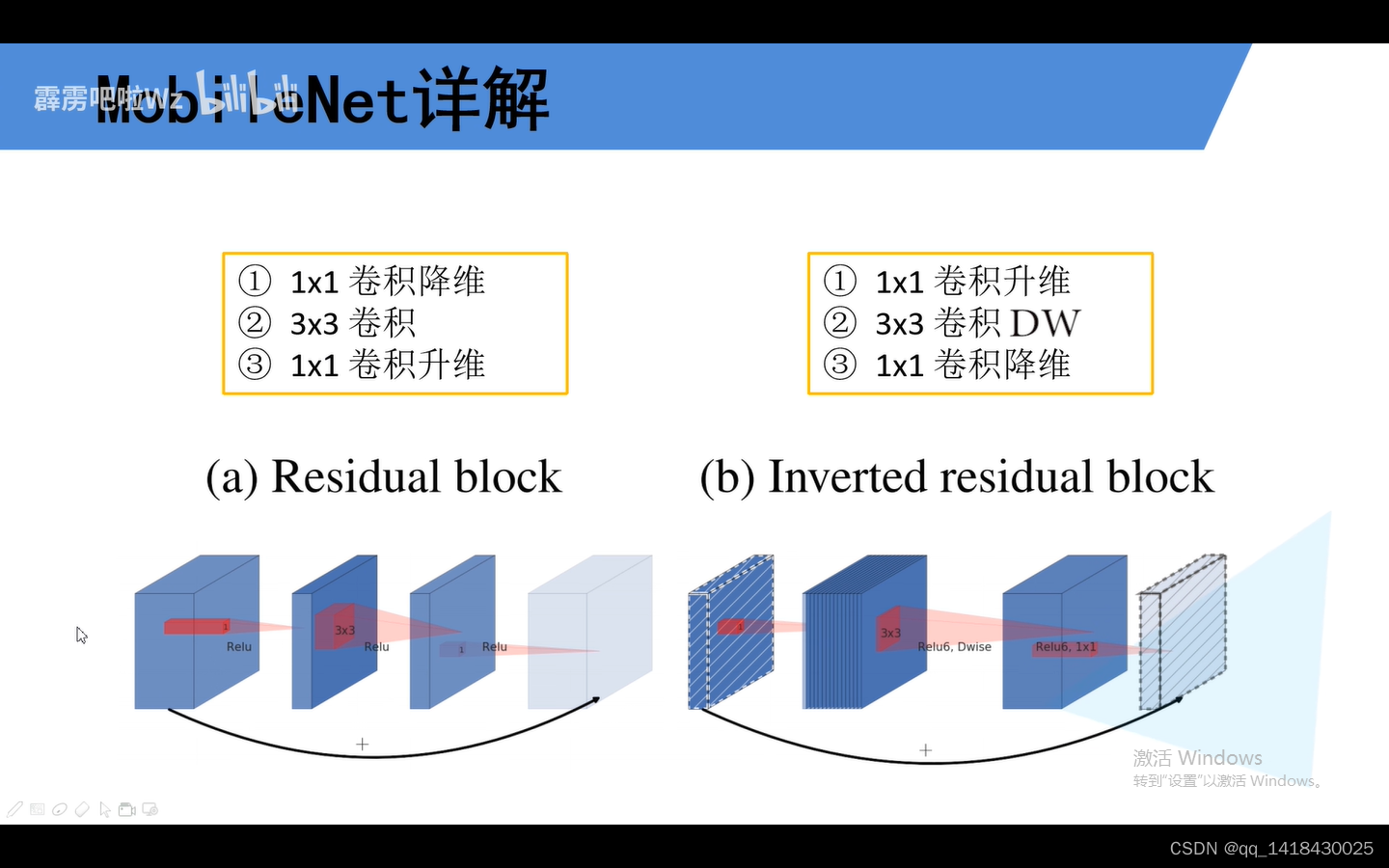
ResNet残差结构是先是1x1降维,然后是3x3卷积处理,最后1x1卷积升维。(“V”,两头大,中间小)
Inverted Residual Block是先1x1升维,然后是3x3卷积DW,最后是1x1卷积降维。(^,两头小,中间大)
激活函数也不一样,一个是Relu,一个是Relu6
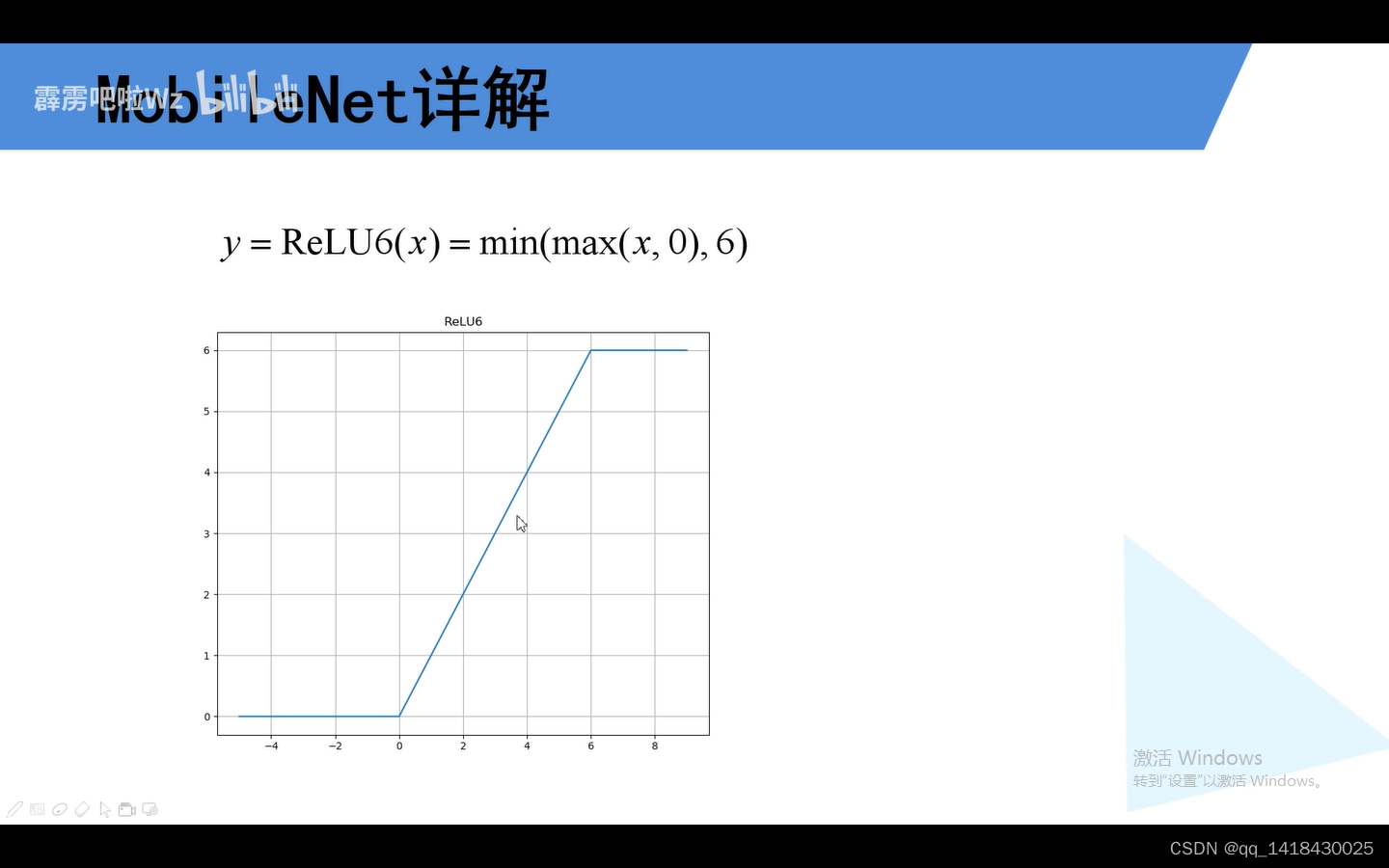
Relu6L:当输入小于0时候,置为0;当输入大于0小于6时候,相当于y=x,大于6时候,置为0。
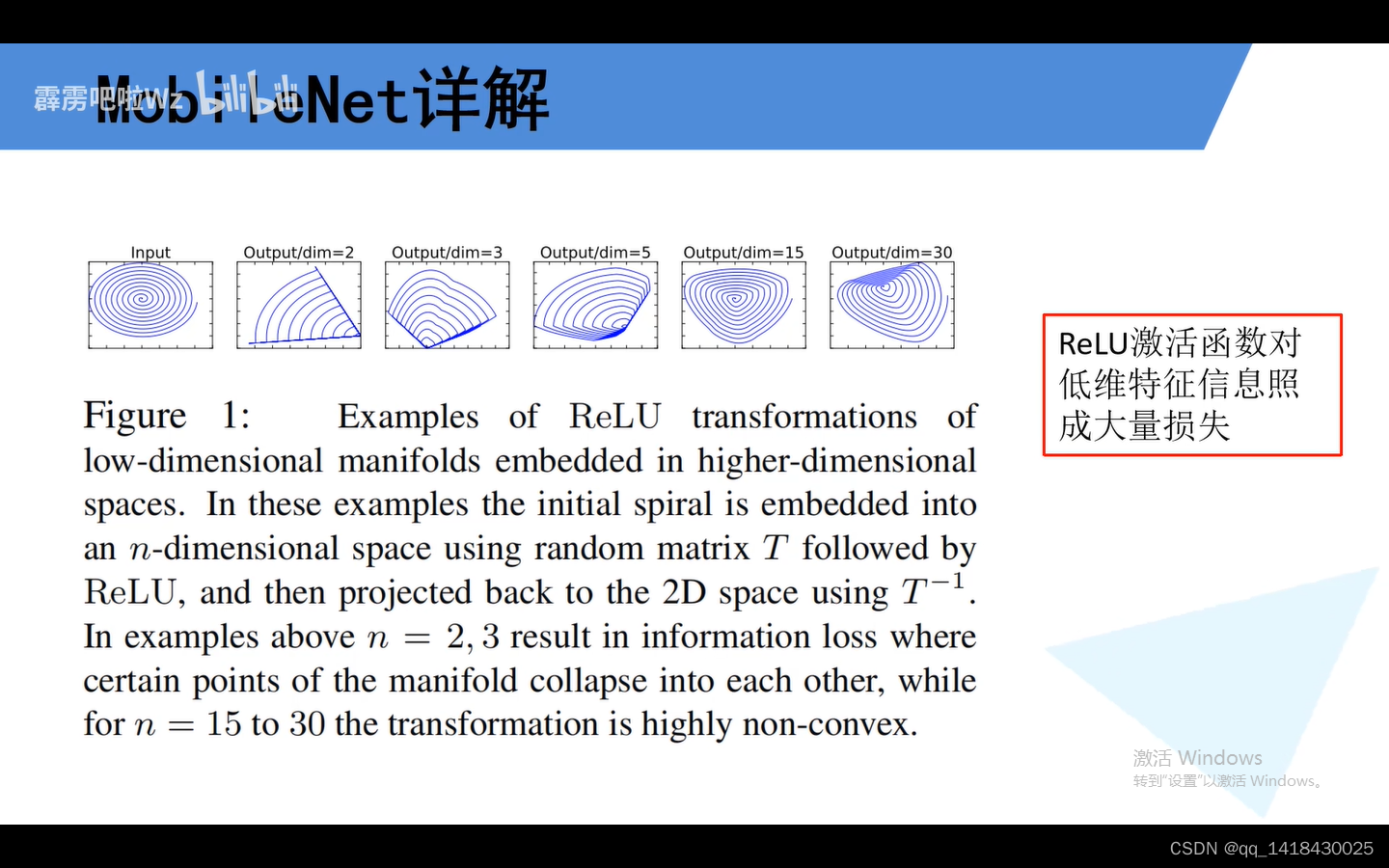
Relu激活函数对低维度特征信息造成大量损失。
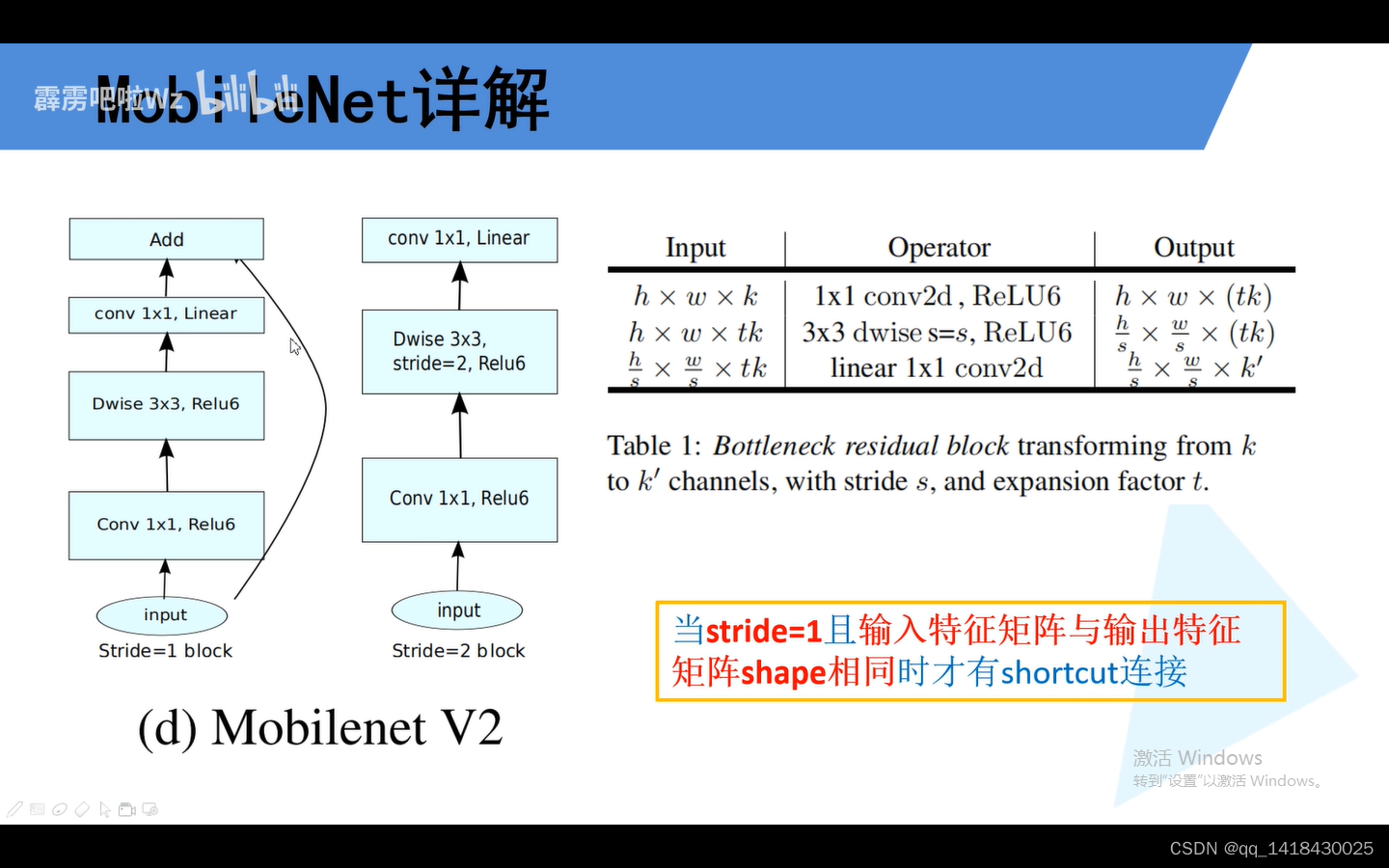
MobileNetv2先1x1升维卷积(Relu6),然后是3x3卷积DW(Relu6),最后是1x1卷积降维(Linear线性激活)。(^,两头小,中间大)
t是扩展因子,前一个卷积得到的输出矩阵的深度是后一个卷积的输入矩阵的深度,DW卷积不改变输入和输出的通道数。
当步距=1时候且输入特征矩阵与输出矩阵的shape相同时候才有shortcut连接。
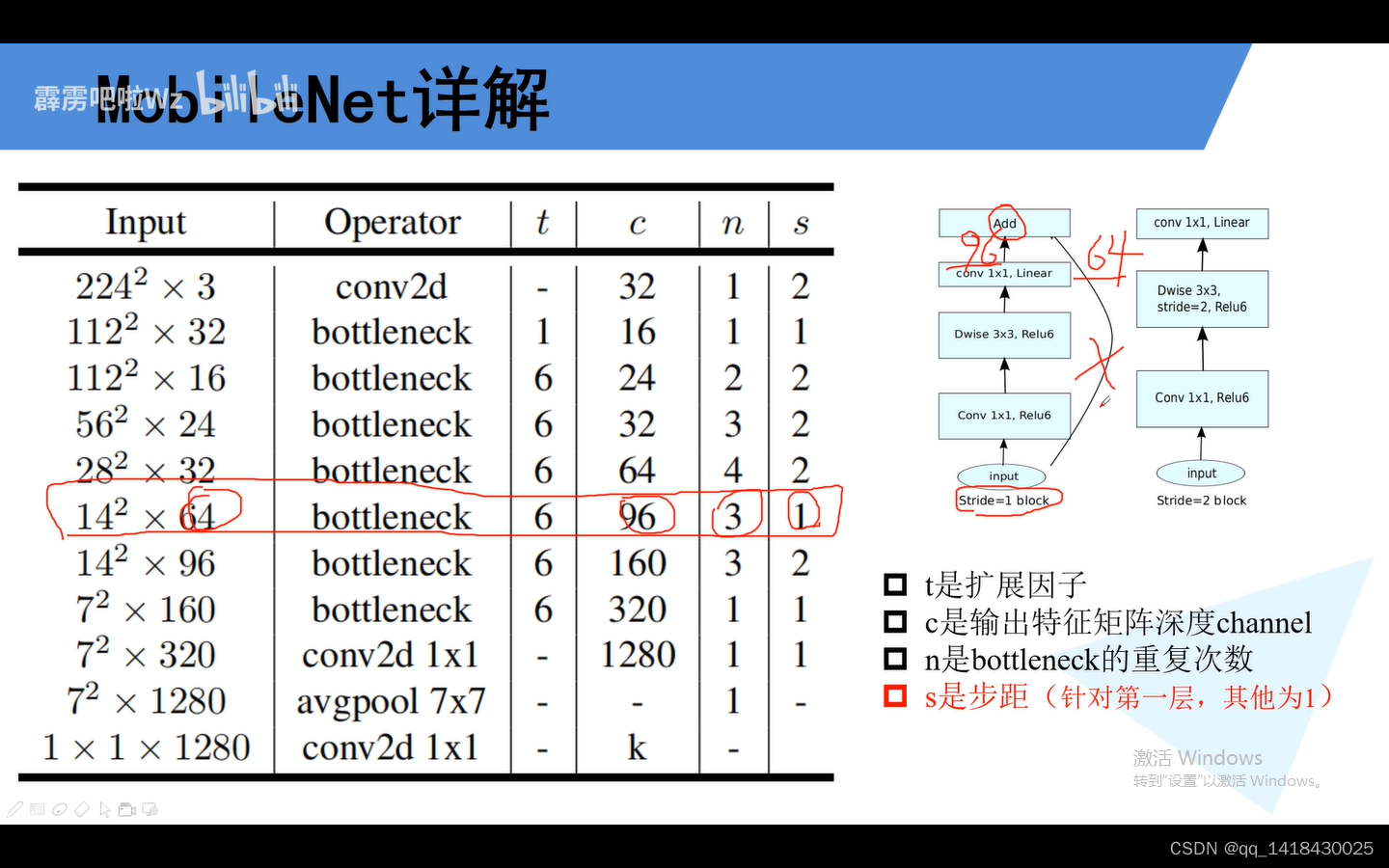
t扩展因子,c是输出特征矩阵的深度channel,n是bottleneck(倒残差结构)重复次数。s是步距(一个block由一系列bottleneck组成):比如bottleneck,n=2时候,bottleneck重复两遍,对他而言,第一层bottleneck的步距为2,第二层为1.
当步距=1时候且输入特征矩阵与输出矩阵的shape相同时候才有shortcut连接。上图的block,他采用了三个bottleneck结构,stride=1,按照论文应该有捷径分支,但实际上是没有的。因为输入特征矩阵深度是=64,而输出特征矩阵深度是=96,深度不一样,不可以直接相加,即没有捷径分支。

当步距=1时候且输入特征矩阵与输出矩阵的shape相同时候才有shortcut连接。上图的block,他采用了三个bottleneck结构,stride=1,按照论文应该有捷径分支,但实际上是没有的。因为输入特征矩阵深度是=64,而输出特征矩阵深度是=96,深度不一样,不可以直接相加,即没有捷径分支。
对于第二层bottleneck而言,步距=1,输入特征矩阵深度=上一层输出特征矩阵深度96,输出特征矩阵=96,宽高也不发生变化,可以有捷径分支。
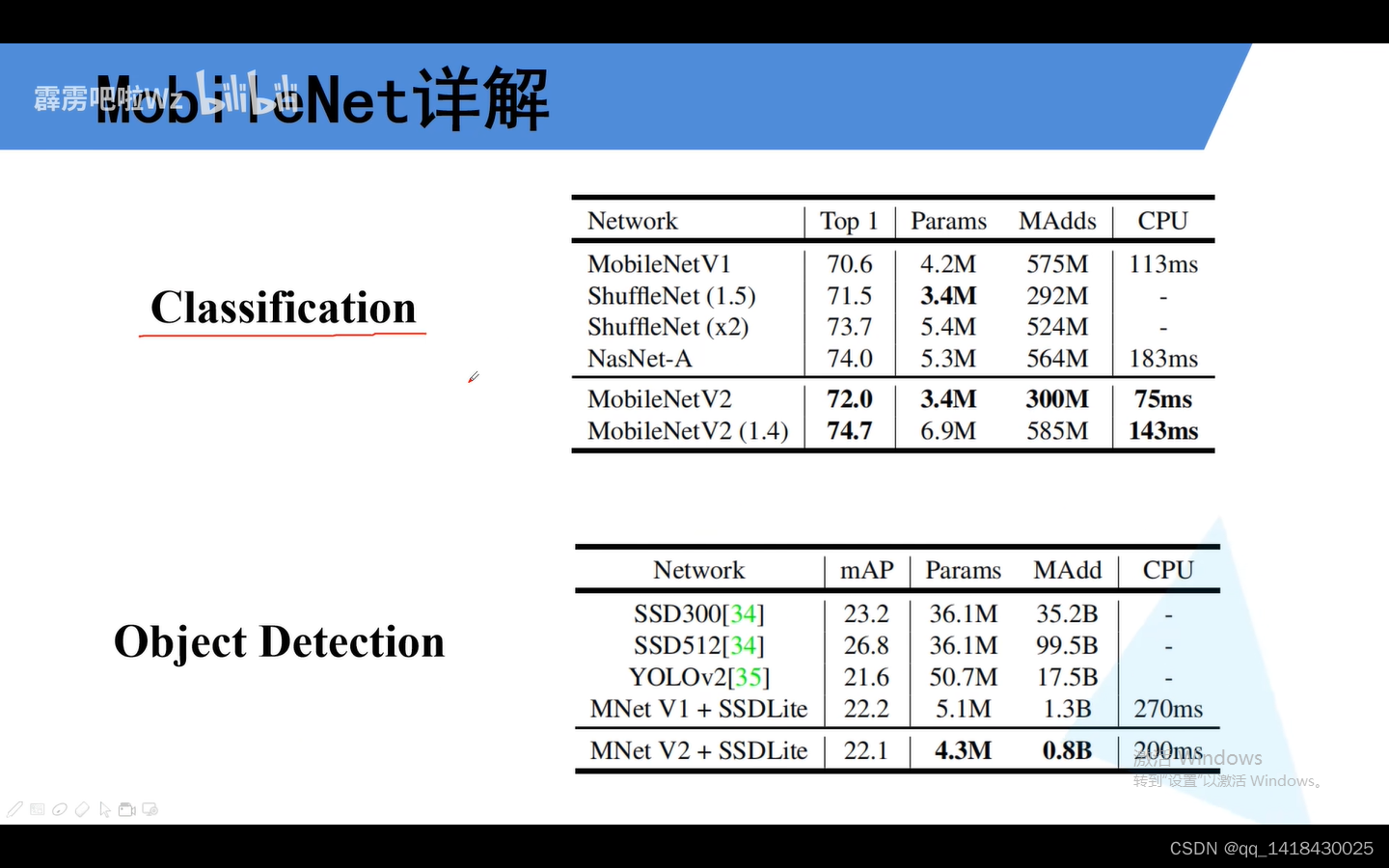
性能对比在CPU上,移动设备实时处理。感觉就是也有点神奇。
五、MobileNetv3

MobileNet网络,更新Block(bneck)
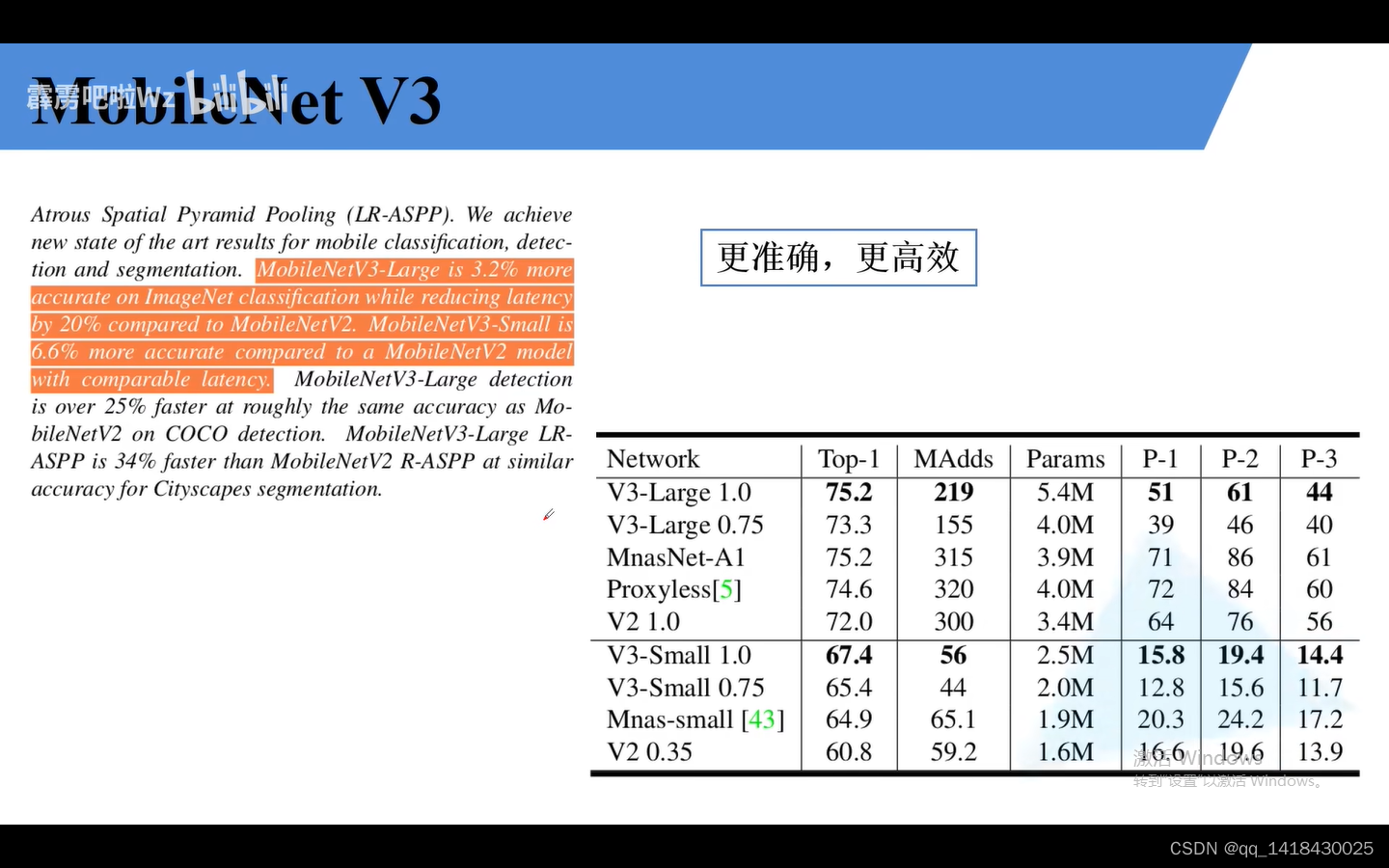
MobileNetV3在Image Net上比MobileNetV2性能提高20%,在延时上比MoblieNetV2延时少6.6%。
总结:MobileNetV3在精确度和延时上比较好。

MobileNetV2就是先是1x1卷积升维(BN+Relu6),然后再3x3卷积DW卷积(BN+Relu6),最后1x1卷积降维(Relu6)。
1.增加了SE模块(注意力机制):针对特征矩阵的每一个channel进行池化处理,channel是多少,一维向量就有多少个元素。再通过两个全连接层得到输出向量。第一个全连接层节点数目是通道数的1/4,第二个全连接层节点数目是和通道数保持一致。最后输出的是和每一个通道数有关系,赋予不同的权重,即可实现SE模块的功能。

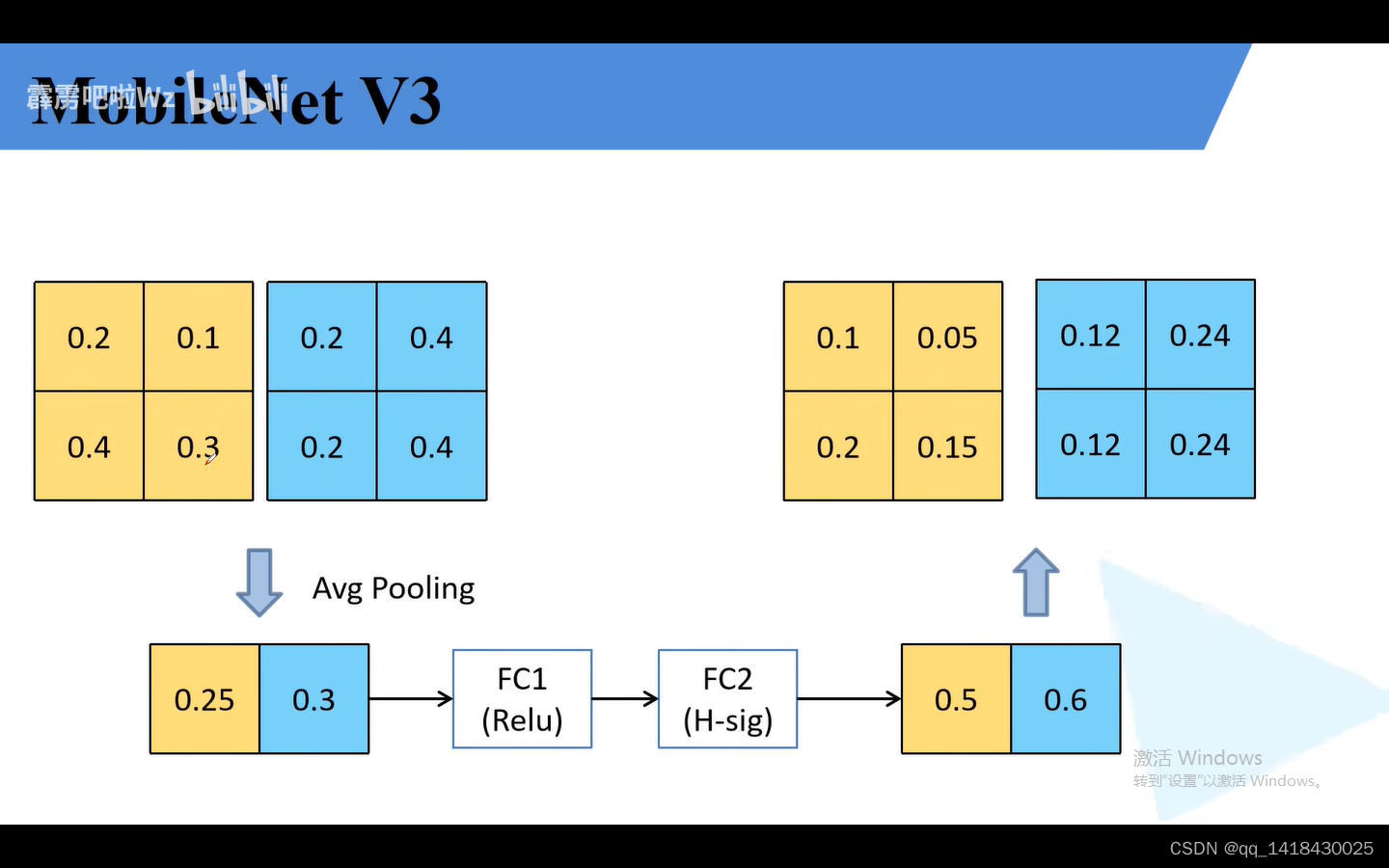
1.SE模块(注意力机制)
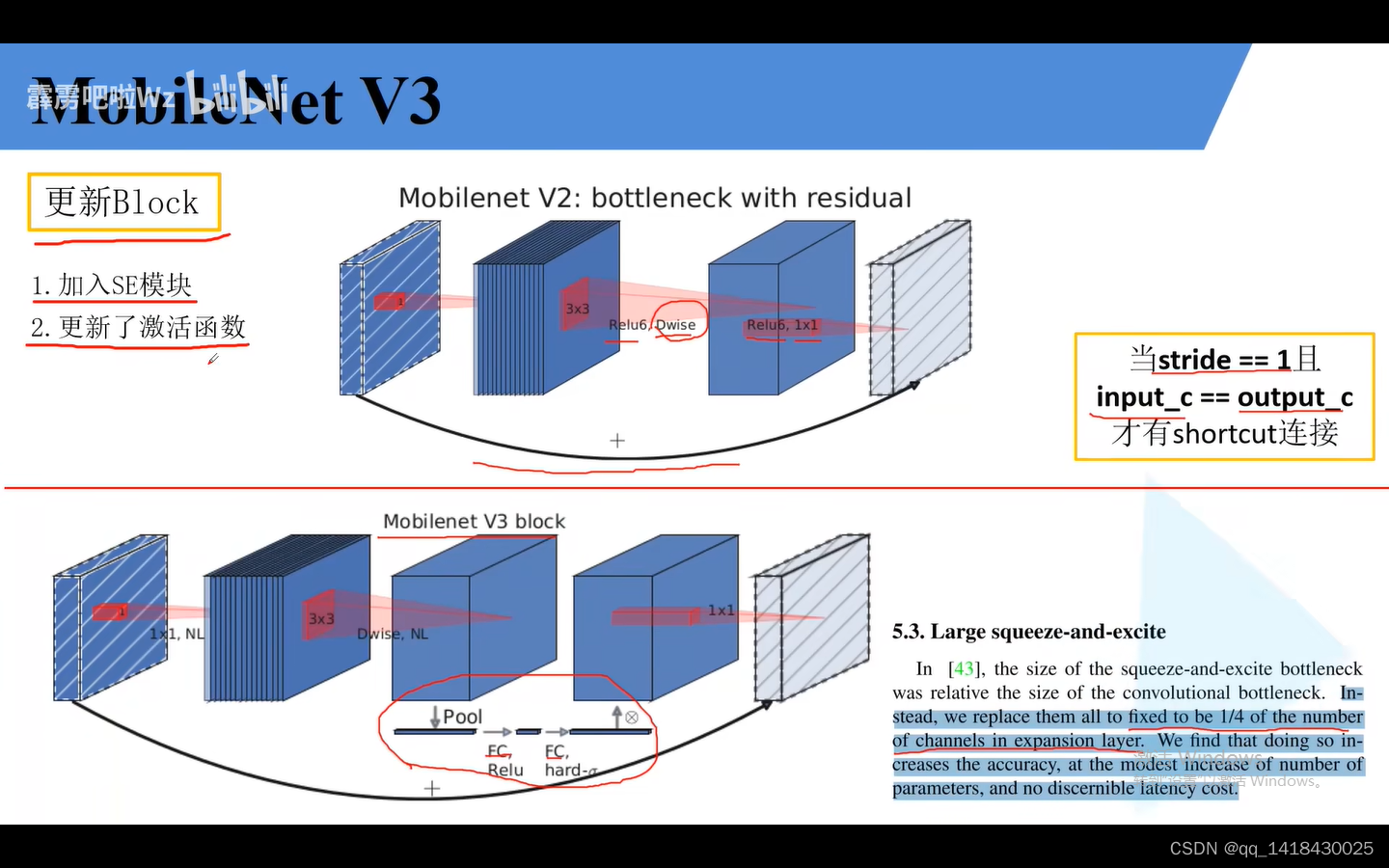
2.NL非线性激活函数,最后的1x1的卷积层没有经过激活函数处理
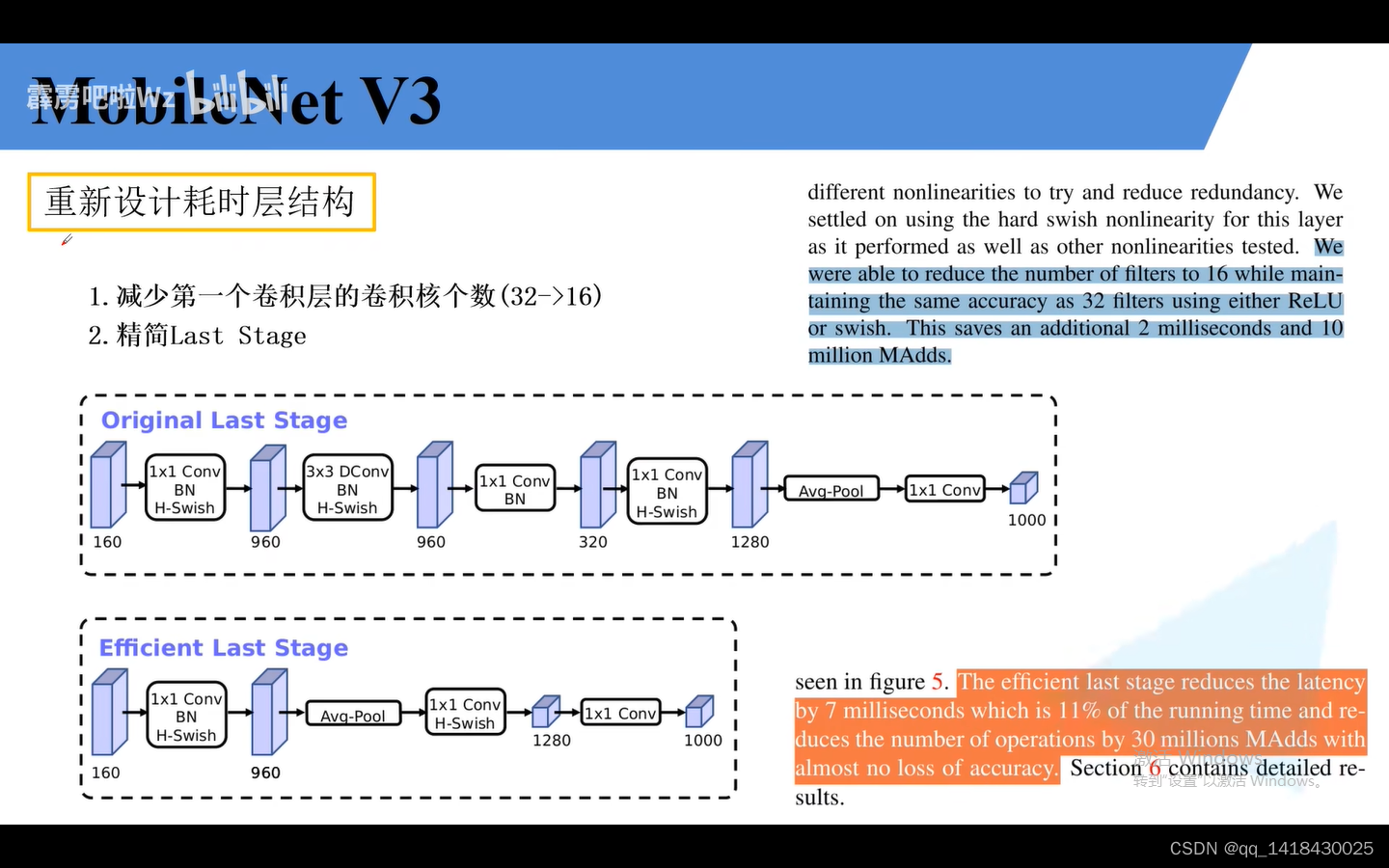
重新设计耗时层结构:
1.减少第一个卷积层的个数,由32变为16准确度差不多。但是参数减少和时间减少。
2.Efficient Last Stage减少运算参数。
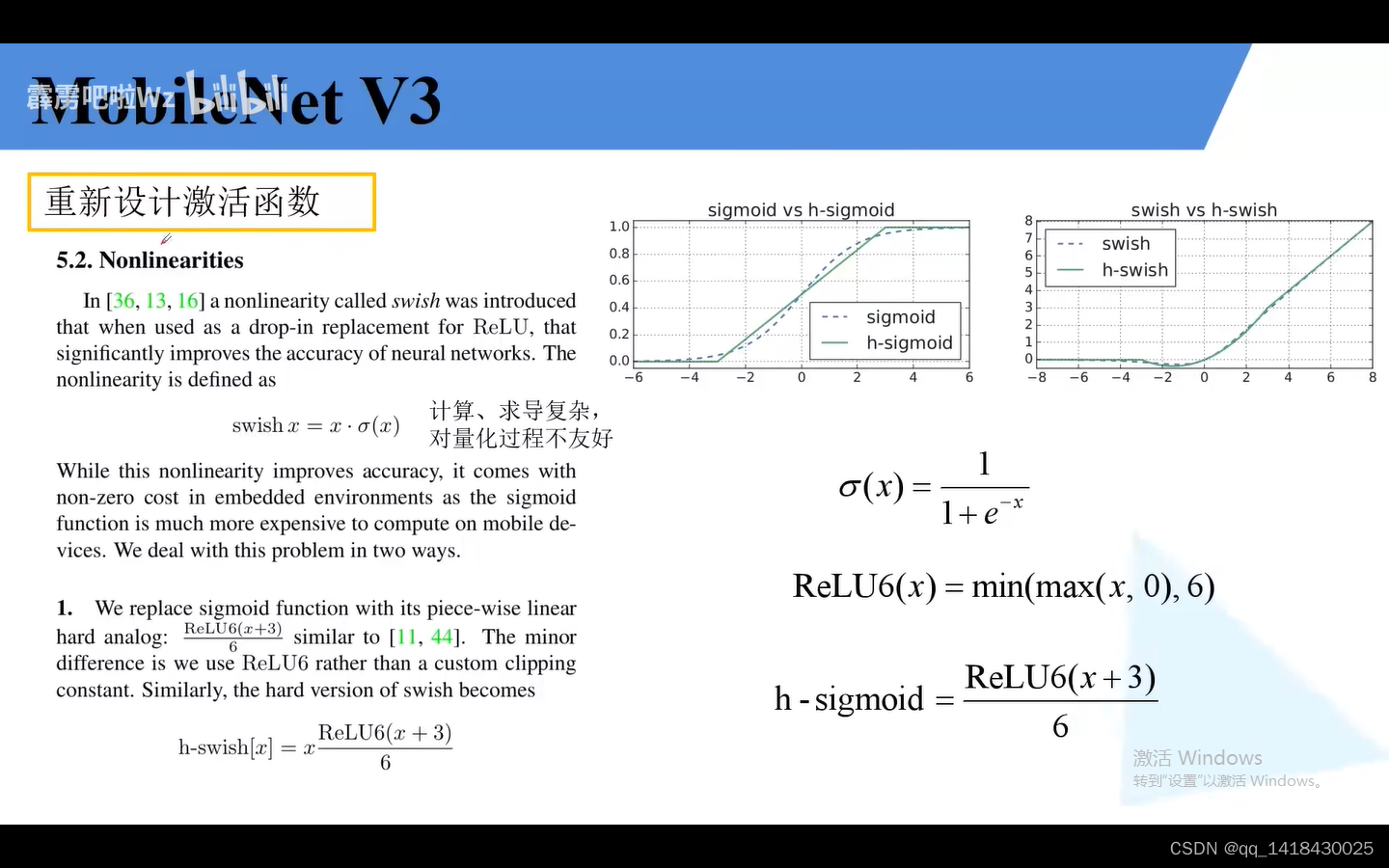
SWISH函数计算求导不方便,h-swish函数比较方便。可以用h-sigmoid函数替代sigmoid函数,两个曲线相似。

























 776
776











 被折叠的 条评论
为什么被折叠?
被折叠的 条评论
为什么被折叠?










